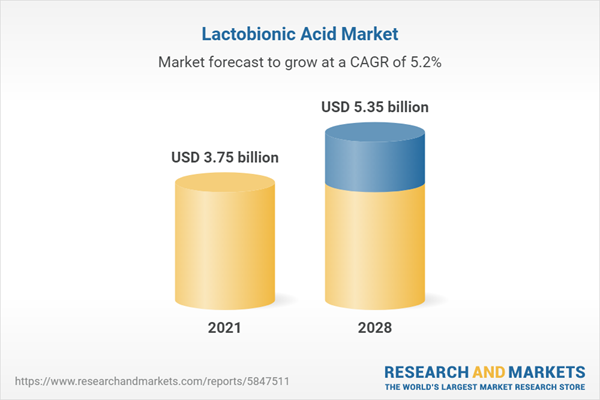The global lactobionic acid market is expected to grow at a CAGR of 5.21% from US$3.751 billion in 2021 to US$5.352 billion in 2028.
The disaccharide lactose is oxidized to produce lactobionic acid. It is a molecule in which galactose, a sugar, is joined to the PHA gluconolactone. More polar and bulky than PHAs, lactobionic acid also has the advantages of being a potent antioxidant and an iron chelator. It has emerged as a versatile polyhydroxy acid with many intriguing uses in the chemical, food, pharmaceutical, cosmetic, and food sectors.The main market drivers are the broad range of uses for lactobionic as a bioactive component, particularly in medicine, its enormous demand in cosmeceuticals, and the popularity of biodegradable goods. The variety of uses for lactobionic acid in meat and animal products has led to an increase in its demand in the food sector. Many health-related goods, including medications, antibiotics, and fluids used in organ donation, include lactobionic acid.
In transplantation medicine, this preservation solution has been widely accepted as the gold standard for clinical dissolution of organ perfusion because it helps prevent free radical damage to tissues while organs are preserved. Additionally, lactobionic acid can stabilize pharmaceutical formulations that include delicate medicinal components. Vaccine-stimulated immune responses against breast tumors are facilitated by lactobionic acid, a unique high-affinity inhibitor molecule of carbohydrate-binding proteins, which may result in tumor regression and increased survival rates. Dietary supplements with lactobionic acid added help to avoid calcium deficiencies.
Pharmaceutical and health industries are driving the demand for lactobionic acid.
Pharmaceuticals, antibiotics, and preservation solutions for organ transplantation are just a few of the health-related goods that frequently employ lactobionic acid. Additionally, lactobionic acid serves as a stabilizer for pharmaceutical preparations that include potent medicinal ingredients. Vaccine-stimulated immune responses against breast tumors are promoted by lactobionic acid, a particularly high-affinity inhibitor chemical of carbohydrate-binding proteins that may result in tumor regression and a better survival outcome. The diseases caused by calcium shortage are prevented by adding lactobionic acid to dietary supplements.Growing knowledge of lactobionic acid's benefits impacts its demand from the cosmetics industry.
For delicate skin types that cannot tolerate deeper forms of exfoliation, lactobionic acid exfoliates the top superficial layers of the skin. The antioxidant properties of the substance give your skin a slight glow and aid in enhancing skin tone and texture. According to certain research, lactobionic acid can enhance the skin's lipid barrier to shield it from other environmental aggressors and protect against V damage. The substance is highly prized for its capacity to lighten skin discoloration and fine wrinkles. It is also vital to many cosmetics that help skin shine and add luster.North America will remain the major lactobionic acid market throughout the forecast period.
A significant regional driver is the new uses for lactobionic acid in cosmetics. A large portion of the lactobionic acid consumed in North America is shipped from China and Europe to fulfill demand. The medical and pharmaceutical industries in the area use lactobionic acid most frequently. The food and feed industry's need for this organic acid has increased due to its multifunctional value addition. The food sector has seen a considerable demand increase since the USFDA approved its use as a food additive in various food products.Market Developments:
- In May 2022, Reliable Biopharmaceutical LLC increased its lactobionic acid (LBA) production capacity. Production of Lactobionic Acid has increased by 50% due to the expansion.
- In March 2021, the launch of AmLactin®'s new Rapid Relief Restoring Cream was announced by Sandoz I c. today. The brand's moisturizing product collection has expanded with this new cream's introduction. AmLactin Rapid Relief Restoring Cream, which contains 15% lactic acid, is a daily moisturizer that immediately improves the look of the skin.
Market Segmentation:
By Application
- Cosmetics
- Food
- Pharmaceutical and Medical applications
- Others
By Geography
- North America
- United States
- Canada
- Mexico
- South America
- Brazil
- Argentina
- Others
- Europe
- United Kingdom
- Germany
- France
- Spain
- Others
- Middle East and Africa
- Saudi Arabia
- UAE
- Israel
- Others
- Asia Pacific
- Japan
- China
- India
- South Korea
- Indonesia
- Thailand
- Others
Table of Contents
Companies Mentioned
- Sandoz INC.
- Bio-Sugars Technology Co. LTD
- Merck Group (Sigma-Aldrich)
- Reliable Biopharmaceutical LLC
- Hangzhou Dayangchem Co.LTD.
- Wuxi Sigma Chemical Products Co.LTD.
- Cayman Chemical Company
- Extrasynthese
Table Information
| Report Attribute | Details |
|---|---|
| No. of Pages | 134 |
| Published | June 2023 |
| Forecast Period | 2021 - 2028 |
| Estimated Market Value ( USD | $ 3.75 billion |
| Forecasted Market Value ( USD | $ 5.35 billion |
| Compound Annual Growth Rate | 5.2% |
| Regions Covered | Global |
| No. of Companies Mentioned | 8 |









